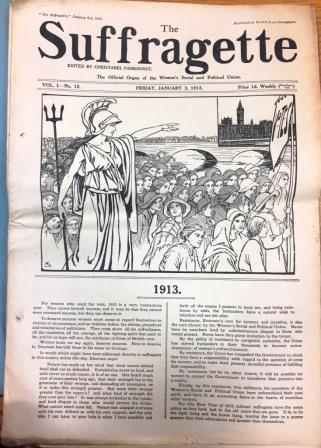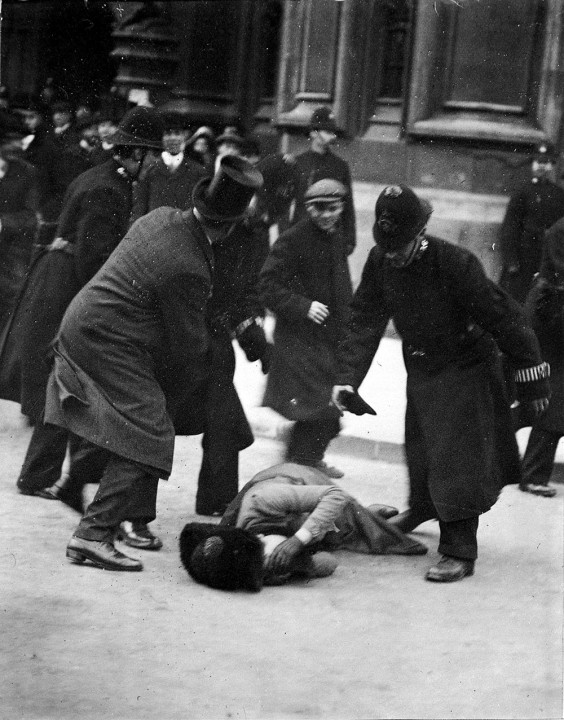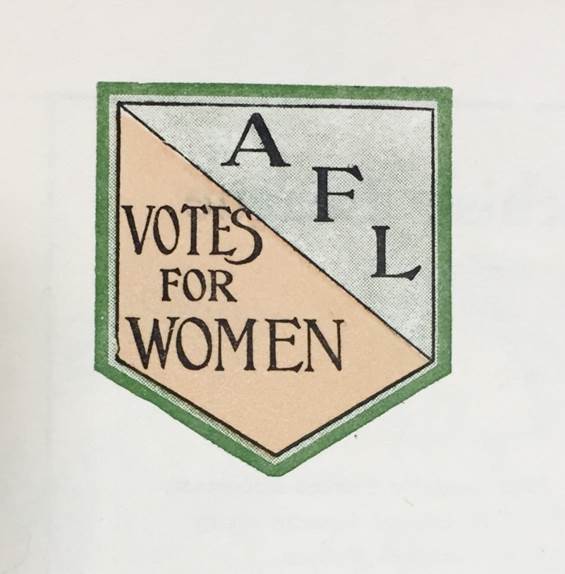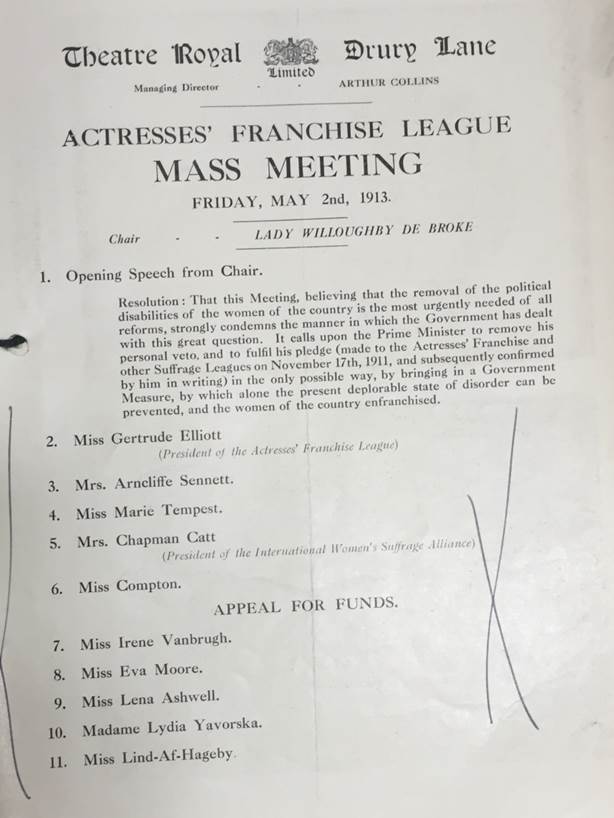
The Suffragette, the official organ of the Women’s Social and Political Union, Jan 1913. Catalogue reference: ASSI 52/212
On 6 February 1918, the Representation of the People Act received royal assent, enfranchising approximately 5.6 million more men and 8.4 million women.
As the centenary of partial votes for women is fast approaching, we would like to encourage you to share any stories that may have passed down the generations about members of your family who helped campaign for the vote.
The women’s suffrage movement touched every part of the country and would have, at times, appeared daily in local and national newspapers. The history of this movement is woven into streets and buildings all around us – memories of marches, pilgrimages, mass meetings and even destruction of property.
This vast political movement mobilised many for the cause, to greater and lesser extents and through many different means of campaigning. The centenary is a wonderful chance to shine a light on little-known campaigners, from the foot-soldiers aiding the militant movement to the seller’s of pro-suffrage newspapers, such as the ‘The Common Cause’.
- Did your ancestor have a distant suffrage connection?
- Did they get arrested for the cause?
- Maybe there’s a family rumour they were involved in the dramatic Black Friday protests?
- Did they attend mass open-air meetings?
- Did one of your female forebears have copies of ‘The Suffragette’?

Believed to be suffragette Ernestine Mills at Black Friday demonstration November 1910. Catalogue reference: COPY 1/551.
We would love to hear all sorts of stories of people involved in the movement: so often it is largely the figureheads who are remembered. In our government files we often find names of less well-known suffrage supporters – indeed the index we hold has the names of 1,333 suffragettes arrested for the cause, including over 100 men. This Home Office suffrage amnesty is one of the single best sources in our collection, providing a rich source for tracing suffragettes, militant campaigners, and family history.
The societies we talk generally talk about in relation to suffrage history are often the same ones, but maybe you have a relative who was part of the Actresses Franchise League or the Tax Resistance League. Or perhaps they boycotted the 1911 census?

Actresses’ Franchise League logo, from a document on Suffrage disturbances. Catalogue Reference: HO 45/10695/231366

DISTURBANCES Suffragettes’ activities and meetings. Reports on the Actresses’ Franchise League. Catalogue reference: HO 45/10695/231366.
A colleague’s chance meeting with a suffrage descendant wonderfully united The National Archives Home Office records on Eileen Casey with family memories. Read more about Eileen’s suffrage story on this blog. If you’ve found an ancestor in our suffrage records, please do let us know!
Our collection reflects the interests of the government and offers an insight into how it responded to civil disobedience and changes to public opinion. If you are interested in trying to trace a family member involved in the suffrage movement you can use our Women’s Suffrage research guide or the London School of Economics blog on Was your (great) grandmother a suffragette?
We would love it if 2018, and the build up to it, is the time you take the chance to delve through some family records or ask a relative what they remember of the generation before them.
With this momentous anniversary looming, maybe it’s time to have another root around in your attic?
Please share your stories and comment below.
Our new events programme is now online: find our suffrage listings until the end of March.
Find suffrage events listings from across the UK at https://www.vote100.uk/event-directory
My Great, Great Grandmother was Adelaide Knight, a key figure in the East End women’s movement. She chained herself to the railings outside Buckingham Palace and was also arrested and served a prison sentence.
I’ve always been inspired by Adelaide’s story. What a wonderful ancestor to have! As she was arrested there is a good chance we would have a record relating to her.
Hello Charli I am an artist and I am making a huge photo mosaic art installation very soon that will be unveiled at Birmingham New Street very soon to celebrate 100 years off women’s vote. I am looking for people who are descendants of Suffragists and have photos and stories. I want to feature you in my artwork and your stories and talk to you. I need to hear from you as soon as possible. Please visit this link Thanks Helen https://thepeoplespicture.com/thefaceofsuffrage
Emily Davison is a not so distant relative
Amazing! We have many documents relating to her (including some of her early prison stays and adventures in parliament!)
If you are interested in researching her more we can offer advice through our Contact Us form: https://www.nationalarchives.gov.uk/contact-us/make-a-records-and-research-enquiry/
Nicola
In 2013 I curated an exhibition at Epsom & Ewell’s Bourne Hall Museum to mark the centenary of the death of Emily Wilding Davison. I would like to hear from you.
Hello Nicola I am an artist and I am making a huge photo mosaic art installation very soon that will be unveiled at Birmingham New Street very soon to celebrate 100 years off women’s vote. I am looking for people who are descendants of Suffragists and have photos and stories. I want to feature you in my artwork and your stories and talk to you. I need to hear from you as soon as possible. Please visit this link Thanks Helen https://thepeoplespicture.com/thefaceofsuffrage
Hello Nicola, I am an artist and I am making a huge photo mosaic art installation very soon that will be unveiled at Birmingham New Street very soon to celebrate 100 years off women’s vote. I am looking for people who are descendants of Suffragists and have photos and stories. I want to feature you in my artwork and your stories and talk to you. I need to hear from you as soon as possible. Please visit this link Thanks Helen https://thepeoplespicture.com/thefaceofsuffrage
Not quite an ancestor but my great-aunt Janet (Jenny) McCallum was a member of the Women’s Freedom League from Dunfermline. She was arrested in 1908 at a demonstration at Westminster and went to Holloway prison for a short time.
Her name was recorded as Jane McCollum so this is a lesson to researchers about looking for name variations! I already knew from other sources that she had been arrested and the approximate date, so it was possible to identify her in the newspaper report and prison list at the National Archives anyway.
Later she became a trade union official in the textile workers’ union, and family sources suggest she was friendly with some ILP leaders.
What an incredible life! The Women’s Freedom League definitely deserve more attention in the history books.
Hello Sheila I am an artist and I am making a huge photo mosaic art installation very soon that will be unveiled at Birmingham New Street very soon to celebrate 100 years off women’s vote. I am looking for people who are descendants of Suffragists and have photos and stories. I want to feature you in my artwork and your stories and talk to you. I need to hear from you as soon as possible. Please visit this link Thanks Helen https://thepeoplespicture.com/thefaceofsuffrage
Yes, Elizabeth Webb nee Bakewell was a key organiser in Adelaide South Australia. No one in my family today knew of the linkage until I went looking into the distant past with its many secrets. Elizabeth was the daughter of my Great Great Grandfather Samuel Bakewell a pioneer to South Australia and Politician & Greengrocer. Elizabeth’s mother was a Pye though I found out my Great Grandfather Edward Howard BAKEWELL was from a 2nd marriage to the Pye younger sister. Elizabeth’s mother died young cause unknown but may be child birth related. So young Elizabeth spent early years in London with relatives. While she went on to achieve great things it is peculiar my Grandmother never spoke of her Step Auntie.
Have links and photos to share if can attach below or provide an email for your project a fantastic endeavor. Women in Adela IU de were first to sit for Parliament so don’t under estimate Bakewell influence in a young SA.
Thanks so much for sharing Elizabeth’s story. It’s great to hear about the Australia suffrage movement!
One of my ancestors was a suffragette. Her name was Jessie Holliday born 5 February 1884, daughter of Henry and Elizabeth (nee Denman) Holliday. Jessie was a member of The Fabian Society.
Jessie was a very interesting character; she was a suffragette and portrait artist, her sitters included (amongst others) George Bernard Shaw and Christobel Pankhurst. Jessie has been described as “a leading light in the early Summer School movement” of The Fabian Society and it was at one of these gatherings (in North Wales in 1910) that she met Edmund Dana, a grandson of the American poet Longfellow, whom she later married.
Jessie was involved in the Food Reform Movement and followed a meat-free and sugar-free diet.
We have records of Jessie attending a march I think in 1908.
Several of Jessie’s portraits are held by the National Porrrait Gallery, and two cousins and I are visiting next week to view them. I have also contacted her old school and the Fabian Society, requested copies of correspondence and articles from the Hull History Centre, and will be visiting the Women’s Library at LSE next week to research her further.
Good luck with all your visits! It sounds amazing to re-trace Jessie’s life.
Our records may help you trace her suffrage story further. If you are interested in researching her more we can offer advice through our Contact Us form: https://www.nationalarchives.gov.uk/contact-us/make-a-records-and-research-enquiry/
Hello Liz I am an artist and I am making a huge photo mosaic art installation very soon that will be unveiled at Birmingham New Street very soon to celebrate 100 years off women’s vote. I am looking for people who are descendants of Suffragists and have photos and stories. I want to feature you in my artwork and your stories and talk to you. I need to hear from you as soon as possible. Please visit this link Thanks Helen https://thepeoplespicture.com/thefaceofsuffrage
Hello Liz, I am an artist and I am making a huge photo mosaic art installation very soon that will be unveiled at Birmingham New Street very soon to celebrate 100 years off women’s vote. I am looking for people who are descendants of Suffragists and have photos and stories. I want to feature you in my artwork and your stories and talk to you. I need to hear from you as soon as possible. Please visit this link Thanks Helen https://thepeoplespicture.com/thefaceofsuffrage
The Canadian Suffrage movement was ‘inert’ and very tame and conservative compared to the British, but the British Suffragettes did invade Canada in 1912 to try to start a militant movement and my husband’s great aunt Edie, a Presbyterian teacher, kept all the clippings.
https://flointhecity-aworkinprogress.blogspot.ca/2015/08/all-about-britains-miss-barbara-wylie.html
Indeed, Sara Kenney, sister of Annie, moved to Montreal in 1910 with her beau, Frank Randall Clarke, a Daily Mail reporter, who had saved her from the police at a UK rally.https://flointhecity-aworkinprogress.blogspot.ca/2015/07/a-real-suffragette-love-affair.html
They married in Montreal so clearly they had to ‘get out of town’ quickly. Another Kenney sister, Caroline, also moved to Montreal in 1913 and tried to start a quasi militant organization. She worked as a teacher for a few years and moved to the US. Sara stayed and Frank become a voice for the working man in Montreal.
Wylie had more luck out West than in Montreal or Toronto, and there’s a plaque to the memory of her visit somewhere out there.
Emily Gibson was married to my Great Great uncle Chambre Corker Townshend.
Her daughter Caroline Charlotte,a stained glass artist,was also a suffragette.
Great to hear you have a suffrage connection Elizabeth.
Our records may help you trace their suffrage story further. We can offer research advice through our Contact Us form: https://www.nationalarchives.gov.uk/contact-us/make-a-records-and-research-enquiry/
My Great Granny was a Suffragette imprisoned for the cause. We have one of the portcullis brooches in the family with one of my cousins. I would love to find out more about her, Granny Wiseman.
Hello Sally, I am an artist and I am making a huge photo mosaic art installation very soon that will be unveiled at Birmingham New Street very soon to celebrate 100 years off women’s vote. I am looking for people who are descendants of Suffragists and have photos and stories. I want to feature you in my artwork and your stories and talk to you. I need to hear from you as soon as possible. Please visit this link Thanks Helen https://thepeoplespicture.com/thefaceofsuffrage
Hello Sally, I am looking for people who are descendants of Suffragists and have photos and stories. I want to feature you in my artwork and your stories and talk to you. I need to hear from you as soon as possible. Please visit this link Thanks Helen https://thepeoplespicture.com/thefaceofsuffrage
My great grandmother Annie Playford was a single mother in 1910, ostracised by her family and having to seek sanctuary with a well meaning neighbour in order to deliver her child safely. She joined the suffrage movement but I imagine most of her time was spent working to survive on the poverty line. Her daughter’s memories were of long hours spent alone while her mother went charring (3 jobs). But they both survived and I am the proud beneficiary.
My third cousin is Lena Connell, the Suffragette photographer. I did read that she would hold meetings at her house.Later after she married she went by the name Beatrice Cundy
I used to work in a building owned by a stained glass painter which contained examples of his work, including what I believe is a pro-suffragette large window. Is it unique?
The family also had an early female photographer in it.
My great grandmother was Mary Titterington from Leeds. Her daughter, Amy, also took part in Suffrage action. Both spent time in Holloway for their activities. Family legend has it that Mary became a Suffragette because Emmeline Pankhurst wrote to Mary asking her to join the Suffrage Movement after she had read the report of Mary’s refusal to pay part of her rates as a ‘passive resister’ to the 1904 Education Act which financed faith schools , in a national newspaper (April 1904). Sadly, we don’t have a copy of the letter but my father maintained that in it Emmeline Pankhurst said that Mary was ‘just the sort of woman I need’.
It is my intention to research Mary’s life further as a retirement project so will be coming Kew at some point.
That’s fascinating Elaine! I would definitely recommend visiting us and using our Suffrage Research guide to help with the process http://www.nationalarchives.gov.uk/help-with-your-research/research-guides/womens-suffrage/
As they were arrested in their fight for the vote I would recommend looking at the Home Office Index of arrests, as a starting point.
Hi Elaine. I work for Leeds Museums and Galleries and we are currently looking into some of the lesser known suffragettes in our region. Mrs Titterington, presumably Mary, sent a postcard to Leonora Cohen in December 1913 which we have in our collections, although we do not have much more information about her. She also appears to have taken part in the working women’s deputation to visit Lloyd George in early 1913. Please feel free to get in touch with me via Abbey House Museum if you have any information you would like to share with us.
My great aunt was Gladys Edkins, who lived in Stratford upon Avon. I have her autograph book, which contains the autographs of Christabel Pankhurst, Helen Fraser, Gladice G Keevil, Constance Collier and some others which are less discernible. Helen Fraser has added the date: 26th April 1909. The evidence points to my great aunt having attended a local meeting (rally?) of the Women’s Suffrage Society at which members of the Actresses’ Franchise League were also present.
Sadly she died young so I never met her or had the chance to ask her about this, but the legacy of her autograph book is a reminder to always exercise my vote.
Other names look like Ethel Dawe, Gail (or April?) Keylight, Helen Haye or Hayl, Leah Hamman, Cissel Sournalez or similar, if anyone knows what they might be.
My grandmother always told me I had to vote, because she had helped to fight for women’s rights. She was born in 1888 and was a cotton weaver in Lancashire. She didn’t marry until she was 30 years old and was a very strong and independent woman and I can imagine her being involved, but unfortunately have nothing in writing. She was a devout Methodist and also involved in the weaver’s union. All her life she was determined that women ought to get equal pay and equal rights in every area of life. I wonder how many women there were like her? During WW1 she continued to work as a weaver and also became a voluntary nurse at the local Sunday School, which was used as a hospital for injured soldiers. My grandad being one of them!
Hello Anne. I am preparing an exhibition at Englesea Brook, a Methodist Heritage Museum, on ‘People, Protest and Politics’ and would love to use your story. Jill
My maternal grandmother (Beatrice Anna Lewis) grew up in Holt just over the border into North Wales. She died in 1976 and sadly I never got to discuss her membership of the women’s suffrage movement in her village and learned of it later through her daughters. Seeing Dr Worsley’s programme about the movement has explained aspects of my grandmother’s character however. She was “a woman born before her time” according to my mother and I saw a kind and lovely person who was none the less frustrated by lack of power in her life. She resented the freedom my grandfather had – resented being given four children (my grandfather “always wanted a large family”) – resented being left at home to raise the children whilst my grandfather served (RAF) abroad (she could have gone with him but he made excuses.) My grandfather used to say “I tell you what I think you need to know my dear.” It did not make for a happy marriage. She had to run the household without any help yet had to do all financial matters in her husband’s name. Her health was always very poor due in no small part to having children after the doctor had told my grandfather that she should not have any more. Whilst she had an Edwardian outlook in many ways, she was a feminist in many respects. I wish she had lived longer into my adulthood so that I could have discussed these matters with her.
As a contrast I once asked my paternal grandmother her what it was like to get the vote. She sniffed and replied “It never did me any good.”
Hi, I’m looking into my grandmother’s maternal family tree for her as she is interested in learning more about her family. She is under the impression her great Aunt was a suffragette and chained herself to the railings. The information I have so far is that her name was Amy or Annie Murray, born around 1886 in Attercliffe, Yorkshire.
I would be incredibly grateful if you had any information on her as I am writing the story of my grandmother’s family for her.
Thank you.
Hi Charlotte,
Sorry for not replying sooner. We are planning a blog post soon on researching suffragette ancestors. Watch this space!
Kind regards,
Liz.
Good Morning I am looking for information about my husband foster grand mother
Elizabet louise Moore wiseman (Lamont married)
married to Cyril Victor Lamont 4 Jun 1938
Hi Johanna,
Thanks for your comment.
We can’t answer research requests on the blog, but if you go to our ‘contact us’ page at http://nationalarchives.gov.uk/contact/ you’ll see how to get in touch with our record experts by email or live chat.
Kind regards, and good luck with your research!
Liz.
Hello, Hope you can help? I am an artist and I am making a huge photo mosaic art installation very soon that will be unveiled at Birmingham New Street very soon to celebrate 100 years off women’s vote. I am looking for people who are descendants of Suffragists and have photos and stories. I want to feature photos in my artwork and your stories and talk to you. I need to hear from you as soon as possible. Please visit this link Thanks Helen https://thepeoplespicture.com/thefaceofsuffrage
Hi! My great grandma was Margaret Annie Romney. Do you have any history about her?
Hello,
In response to your question “Do you have a suffrage ancestor?”, my great great aunt, Jane Savoy, nee Major, pseudonym ‘Mrs. Hughes’ was a most prominent suffragette, being a member of the ELFS. She was my great grandmother’s older sister. Jane was one of six women elected by the ELFS to form a deputation to be received by PM Herbert Asquith on the morning of Saturday, 20th June, 1914. This meeting changed Asquith’s views on women’s suffrage and hence the Representation of the People’s Act 1918 was the result. Jane was the first to speak and The Woman’s Dreadnought recorded the content of the meeting. My whole family were very close friends with Sylvia Pankhurst and George Lansbury, who was Jane’s neighbour in St. Stephen’s Road, Bow. On 6th February, 2018 London BBC News featured a short interview with myself about Jane highlighting the less well known Suffragettes and in August 2018 Who Do You Think You Are? published an article about Jane. She went under the name of Mrs. Hughes (her mother’s maiden name) as her husband was adverse to having his name in the papers. Jane was also involved with setting up Sylvia Pankhurst’s Mother’s Arms creche often having babies left on her’s and my grandmother’s doorsteps. Jane died a day before her 67th birthday on Friday, 13th January, 1928 and in Everybody’s Weekly, 22nd July, 1933, Sylvia Pankhurst published an article about Jane, “Little Band of Slum Mothers who Fought for the Women of England” – her closing words being “Mrs. Savoy’s eyes are closed now in their last sleep. The grey streets of Old Ford Road are greyer and colder for her loss”. Also George Lansbury (who was the figure head leading Jane’s funeral) wrote about her in his book Looking Backwards – And Forwards published in 1935. His chapter “A Woman of the People” ended with the words “Her work follows her, and one day the women of England will lead us out of the misery and degradation of slumdom and poverty, and will do so because millions of Mrs. Savoys have shown by their lives it can and will be done.”
In 2018 it was a wonderful moment when I met Helen Pankhurst and reunited our two families. It was Helen Pankhurst and others that prompted me to apply for a Blue Plaque in Jane’s honour. Jane was brought up in some of the most notorious slums in London, which have all been demolished, along with properties in St. Stephen’s Road. I thought I had found a building still left standing at 14, Wilkes Street, Spitalfields, Whitechapel, where she was born, but this also no longer stands and the present 14, Wilkes Street is not the house that Jane was born in! There is a gap in Jane’s whereabouts between the 1871 and 1891 censuses, apart from 1885, so I may still have a chance to find a property still left standing!!
I knew “Aunt Jinny” was a suffragette and used to chain herself to the railings (avoiding prison), but I couldn’t be more proud to learn that I’m related to such a kind, strong willed and determined woman as Jane Savoy, who took part in changing English history allowing every woman to now have the vote.